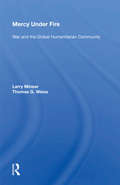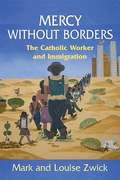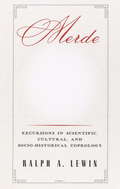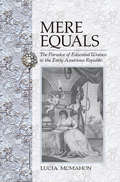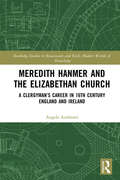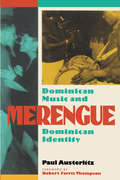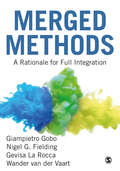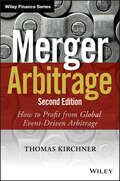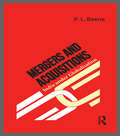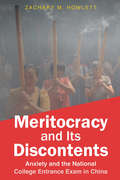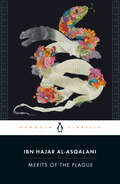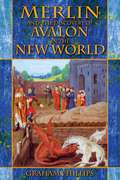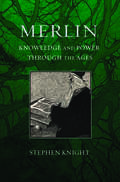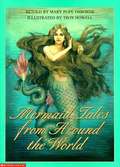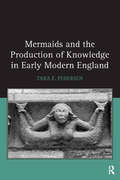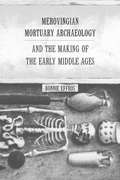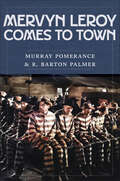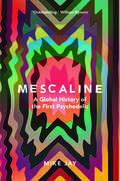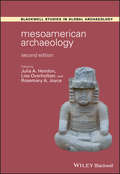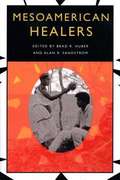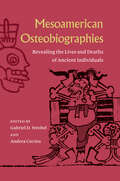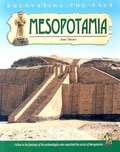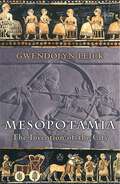- Table View
- List View
Mercy Under Fire: War And The Global Humanitarian Community
by Larry MinearFrom Bosnia to Somalia, and most recently from Rwanda to Angola and the Sudan, humanitarian aid and international interventions have gone awry. Although the need for humanitarian assistance has not diminished in the wake of the Cold War, success stories will almost certainly be harder to come by. This book addresses that grim prospect. Based on sch
Mercy Without Borders: The Catholic Worker And Immigration
by Mark Zwick Louise ZwickThis book is the Zwick's' story, a Catholic Worker story, interwoven with the stories, the joys, hopes, and tragedies of immigrants who have come to Houston, and an impassioned plea for a change in the political and economic forces which drive people to immigrate.
Merde
by Ralph A. LewinMerde is an unusual (very unusual) and witty investigation into a subject you may always have wondered about--but didn't know quite what to ask. History, biology, anthropology, culture, animal behavior--all of these are the real subjects of Merde. Why can some animals do it on the run, and others can't? Why does camel dung make good fires? What are the fascinating stories of the dung beetles? Myths and legends, physical features, health and disease, uses for construction and as fertilizers--even nutritional values!--Ralph Lewin writes about them all in the most ingratiating and sophisticated and yet scientific way. Merde is also full of personal adventures and observations, as well as anecdotes and examples. The scattered literature on this subject is voluminous, but until now no one has perused and compiled it all and given it a personal touch, so to speak. It will be hard not to talk about this treasure trove of a book after you've finished it--or perhaps even when you're in the middle of it.From the Hardcover edition.
Mere Equals: The Paradox of Educated Women in the Early American Republic
by Lucia McmahonIn Mere Equals, Lucia McMahon narrates a story about how a generation of young women who enjoyed access to new educational opportunities made sense of their individual and social identities in an American nation marked by stark political inequality between the sexes. McMahon's archival research into the private documents of middling and well-to-do Americans in northern states illuminates educated women's experiences with particular life stages and relationship arcs: friendship, family, courtship, marriage, and motherhood. In their personal and social relationships, educated women attempted to live as the "mere equals" of men. Their often frustrated efforts reveal how early national Americans grappled with the competing issues of women's intellectual equality and sexual difference.In the new nation, a pioneering society, pushing westward and unmooring itself from established institutions, often enlisted women's labor outside the home and in areas that we would deem public. Yet, as a matter of law, women lacked most rights of citizenship and this subordination was authorized by an ideology of sexual difference. What women and men said about education, how they valued it, and how they used it to place themselves and others within social hierarchies is a highly useful way to understand the ongoing negotiation between equality and difference. In public documents, "difference" overwhelmed "equality," because the formal exclusion of women from political activity and from economic parity required justification. McMahon tracks the ways in which this public disparity took hold in private communications. By the 1830s, separate and gendered spheres were firmly in place. This was the social and political heritage with which women's rights activists would contend for the rest of the century.
Meredith Hanmer and the Elizabethan Church: A Clergyman’s Career in 16th Century England and Ireland (Routledge Studies in Renaissance and Early Modern Worlds of Knowledge)
by Angela AndreaniThis is the first book-length study of the fascinating life of the clergyman and scholar of Welsh descent Meredith Hanmer (c.1545–1604). Hanmer became involved in the key scholarly controversies of his day, from the place of the Elizabethan Church in Christian history to the role of the 1581 Jesuit mission to England led by Edmund Campion and Robert Persons. As an army preacher in Ireland during the Nine Years War, Hanmer campaigned with the most acclaimed soldiers of his day. He nurtured connections with prominent intellectuals of his time and with the key figures of colonial government. His own career as a clergyman was colourful, involving bitter disputes with his parishioners and recurring aspersions on his character. Surprisingly, no study to date has centred on this intriguing character. The surviving evidence for Hanmer’s life and activities is unusually rich, comprising his published writings and a large body of under-exploited manuscript material. Drawing extensively on archival evidence scattered across a wide number of repositories, Dr. Andreani’s book contextualises Hanmer’s clerical activities and wide-ranging scholarship, elucidates his previously little understood career, and thus enriches our understanding of life, politics, and scholarship in the Elizabethan church.
Merengue: Dominican Music and Dominican Identity
by Paul AusterlitzMerengue—the quintessential Dominican dance music—has a long and complex history, both on the island and in the large immigrant community in New York City. In this ambitious work, Paul Austerlitz unravels the African and Iberian roots of merengue and traces its growth under dictator Rafael Trujillo and its renewed popularity as an international music. Using extensive interviews as well as written commentaries, Austerlitz examines the historical and contemporary contexts in which merengue is performed and danced, its symbolic significance, its social functions, and its musical and choreographic structures. He tells the tale of merengue's political functions, and of its class and racial significance. He not only explores the various ethnic origins of this Ibero-African art form, but points out how some Dominicans have tried to deny its African roots. In today's global society, mass culture often marks ethnic identity. Found throughout Dominican society, both at home and abroad, merengue is the prime marker of Dominican identity. By telling the story of this dance music, the author captures the meaning of mass and folk expression in contemporary ethnicity as well as the relationship between regional, national, and migrant culture and between rural/regional and urban/mass culture. Austerlitz also traces the impact of migration and global culture on the native music, itself already a vibrant intermixture of home-grown merengue forms. From rural folk idiom to transnational mass music, merengue has had a long and colorful career. Its well-deserved popularity will make this book a must read for anyone interested in contemporary music; its complex history will make the book equally indispensable to anyone interested in cultural studies.
Merged Methods: A Rationale for Full Integration
by Giampietro Gobo Nigel G. Fielding Gevisa La Rocca Wander van der VaartA new turn in mixed methods research is here: merged methods. This provocative book offers a novel analysis of current mixed methods research, complicating traditional approaches and challenging existing techniques. Moving beyond the binary quantitative-qualitative distinction, the book presents methodologically grounded ways to merge methods in social research and integrate interpretive and structural approaches in one instrument or procedure. The book: Considers the importance of merging both epistemologies and methodologies. Showcases eight merged methods research approaches, from the Delphi method to multimodal content analysis. Explores the opportunities for merging methods using computational techniques, such as text mining. This innovative book is a must-read for any postgraduate student or researcher across the social sciences wanting to develop their understanding of mixed methods research.
Merged Methods: A Rationale for Full Integration
by Giampietro Gobo Nigel G. Fielding Gevisa La Rocca Wander van der VaartA new turn in mixed methods research is here: merged methods. This provocative book offers a novel analysis of current mixed methods research, complicating traditional approaches and challenging existing techniques. Moving beyond the binary quantitative-qualitative distinction, the book presents methodologically grounded ways to merge methods in social research and integrate interpretive and structural approaches in one instrument or procedure. The book: Considers the importance of merging both epistemologies and methodologies. Showcases eight merged methods research approaches, from the Delphi method to multimodal content analysis. Explores the opportunities for merging methods using computational techniques, such as text mining. This innovative book is a must-read for any postgraduate student or researcher across the social sciences wanting to develop their understanding of mixed methods research.
Merger Arbitrage: How to Profit from Global Event-Driven Arbitrage
by Thomas KirchnerMitigate risk and increase returns with an alternative hedge fund strategy Merger Arbitrage: How to Profit from Event-Driven Arbitrage, Second Edition is the definitive guide to the ins and outs of the burgeoning merger arbitrage hedge fund strategy, with real-world examples that illustrate how mergers work and how to take advantage of them. Author Thomas Kirchner, founder of the Pennsylvania Avenue Event-Driven Fund, discusses the factors that drove him to invest solely in merger arbitrage and other event-driven strategies, and details the methods used to incorporate merger arbitrage into traditional investment strategies. And while there is always a risk that a deal will fall through, the book explains how minimal such risks really are when the potential upside is factored in. Early chapters of the book focus on the basics of the merger arbitrage strategy, including an examination of mergers and the incorporation of risk into the arbitrage decision. Following chapters detail deal structures, financing, and legal aspects to provide the type of in-depth knowledge required to execute an effective investment strategy. The updated second edition stresses new, increasingly relevant information like: Worldwide legal deal regimes UK takeover code UK takeover code global offspring Regulators around the world The book provides clear, concise guidance on critical considerations including leverage and options, shorting stocks, and legal recourse for inadequate merger consideration, allowing readers to feel confident about trying a new investment strategy. With simple benefits including diversification of risk and return streams, this alternative hedge fund strategy has a place in even the most traditional plan. Merger Arbitrage: How to Profit from Event-Driven Arbitrage, Second Edition provides the information that gives investors an edge in the merger arbitrage arena.
Mergers and Acquisitions: India under Globalisation
by P. L. BeenaThis book provides a holistic account of developments and patterns of mergers and acquisitions that have taken place in the Indian corporate sector, especially in the post-liberalisation era. It combines astute analyses with up-to-date data to present an all-inclusive picture of globalisation and its impact on business in contemporary India. This will serve as an important resource to researchers, scholars and students of economics, management, business administration, business studies, commerce and corporate law, as well as policy-makers, legal practitioners, industrial houses, and industrial bodies.
Meritocracy and Its Discontents: Anxiety and the National College Entrance Exam in China
by Zachary M. HowlettMeritocracy and Its Discontents investigates the wider social, political, religious, and economic dimensions of the Gaokao, China's national college entrance exam, as well as the complications that arise from its existence. Each year, some nine million high school seniors in China take the Gaokao, which determines college admission and provides a direct but difficult route to an urban lifestyle for China's hundreds of millions of rural residents. But with college graduates struggling to find good jobs, some are questioning the exam's legitimacy—and, by extension, the fairness of Chinese society. Chronicling the experiences of underprivileged youth, Zachary M. Howlett's research illuminates how people remain captivated by the exam because they regard it as fateful—an event both consequential and undetermined. He finds that the exam enables people both to rebel against the social hierarchy and to achieve recognition within it. In Meritocracy and Its Discontents, Howlett contends that the Gaokao serves as a pivotal rite of passage in which people strive to personify cultural virtues such as diligence, composure, filial devotion, and divine favor.
Merits of the Plague
by Ibn Hajar al-AsqalaniThe preeminent meditation on plagues and pandemics from the Islamic world, now in English for the first timeA Penguin ClassicSix hundred years ago, the author of this landmark work of history and religious thought—an esteemed judge, poet, and scholar in Cairo—survived the bubonic plague, which took the lives of three of his children, not to mention tens of millions of others throughout the medieval world. Holding up an eerie mirror to our own time, he reflects on the origins of plagues—from those of the Prophet Muhammad&’s era to the Black Death of his own—and what it means that such catastrophes could have been willed by God, while also chronicling the fear, isolation, scapegoating, economic tumult, political failures, and crises of faith that he lived through. But in considering the meaning of suffering and mass death, he also offers a message of radical hope. Weaving together accounts of evil jinn, religious stories, medical manuals, death-count registers, poetry, and the author&’s personal anecdotes, Merits of the Plague is a profound reminder that with tragedy comes one of the noblest expressions of our humanity: the practice of compassion, patience, and care for those around us.
Merlin and the Discovery of Avalon in the New World
by Graham PhillipsThe first book to present the true identity of the mythic figure Merlin• Uncovers historical evidence that the legend of Merlin was based on the life of a real man• Reveals that Avalon, Merlin’s final resting place, was an island in the United StatesThe legendary figure Merlin is known throughout the world as the wizard of Camelot who was counselor to King Arthur and helped that monarch create the Round Table. Through the course of a 20-year investigation Graham Phillips has uncovered evidence that this famous story was based on the life of an actual historical figure: the son of a Roman consul who became the last of the Romans to rule Britain in the fifth century A.D. Furthermore, the evidence reveals that he died and was buried in what is now the United States.According to legend, Merlin ended his life on the mystical island of Avalon. A 1500-year-old saga tells how Merlin left Britain on a boat bound for a mysterious island to the west. The places described in Merlin’s voyage, Phillips argues, would only have been seen by someone who had journeyed to the New World. For example, the island where boiling fountains bubble from the ground could be the geysers of Iceland, and the island with rivers of ice, the glaciers of Greenland.During his research Phillips discovered that a site believed to be Merlin’s grave was found by the first British settlers in North America: a secret location said to have been preserved in the works of William Shakespeare and the coded writings of the Freemasons. Phillips follows a trail of historical clues that leads ultimately to a mysterious New England tomb. Here a final encrypted message not only reveals the whereabouts of Merlin’s grave but contains evidence that Merlin’s descendants still survive and, through a merger with the Spencer family of Princess Diana, may once again ascend the British throne.
Merlin: Knowledge and Power through the Ages
by Stephen KnightMerlin, the wizard of Arthurian legend, has been a source of enduring fascination for centuries. In this authoritative, entertaining, and generously illustrated book, Stephen Knight traces the myth of Merlin back to its earliest roots in the early Welsh figure of Myrddin. He then follows Merlin as he is imagined and reimagined through centuries of literature and art, beginning with Geoffrey of Monmouth, whose immensely popular History of the Kings of Britain (1138) transmitted the story of Merlin to Europe at large. He covers French and German as well as Anglophone elements of the myth and brings the story up to the present with discussions of a globalized Merlin who finds his way into popular literature, film, television, and New Age philosophy. Knight argues that Merlin in all his guises represents a conflict basic to Western societies-the clash between knowledge and power. While the Merlin story varies over time, the underlying structural tension remains the same whether it takes the form of bard versus lord, magician versus monarch, scientist versus capitalist, or academic versus politician. As Knight sees it, Merlin embodies the contentious duality inherent to organized societies. In tracing the applied meanings of knowledge in a range of social contexts, Knight reveals the four main stages of the Merlin myth: Wisdom (early Celtic British), Advice (medieval European), Cleverness (early modern English), and Education (worldwide since the nineteenth century). If a wizard can be captured within the pages of a book, Knight has accomplished the feat.
Mermaid Tales From Around The World
by Mary Pope OsborneEnchanting tales of sea nymphs from twelve cultures, including Chinese, Iranian, African, and Native American, are eloquently retold by the author in this acclaimed collection.
Mermaids and the Production of Knowledge in Early Modern England
by Tara E. PedersenWe no longer ascribe the term ’mermaid’ to those we deem sexually or economically threatening; we do not ubiquitously use the mermaid’s image in political propaganda or feature her within our houses of worship; perhaps most notably, we do not entertain the possibility of the mermaid’s existence. This, author Tara Pedersen argues, makes it difficult for contemporary scholars to consider the mermaid as a figure who wields much social significance. During the early modern period, however, this was not the case, and Pedersen illustrates the complicated category distinctions that the mermaid inhabits and challenges in 16th-and 17th-century England. Addressing epistemological questions about embodiment and perception, this study furthers research about early modern theatrical culture by focusing on under-theorized and seldom acknowledged representations of mermaids in English locations and texts. While individuals in early modern England were under pressure to conform to seemingly monolithic ideals about the natural order, there were also significant challenges to this order. Pedersen uses the figure of the mermaid to rethink some of these challenges, for the mermaid often appears in surprising places; she is situated at the nexus of historically specific debates about gender, sexuality, religion, the marketplace, the new science, and the culture of curiosity and travel. Although these topics of inquiry are not new, Pedersen argues that the mermaid provides a new lens through which to look at these subjects and also helps scholars think about the present moment, methodologies of reading, and many category distinctions that are important to contemporary scholarly debates.
Merovingian Mortuary Archaeology and the Making of the Early Middle Ages
by Bonnie EffrosThis book makes a major contribution to the study of death and burial in late antique and early medieval society with its long overdue systematic discussion of this mortuary evidence.
Mervyn LeRoy Comes to Town
by Murray Pomerance R. Barton Palmer Tom Conley Mark Osteen Steven Rybin Dominic Lennard Rebecca Bell-Metereau Linda Badley Lawrence Napper Daniel Varndell Adrian Danks David Desser Neil Badmington Matthew Solomon Brenda Austin-Smith Matthew Cipa Kristen Hatch Matthew H. BernsteinMervyn LeRoy Comes to Town is the first book devoted to the career of one of the director/producers who in the early years of sound cinema was instrumental in establishing the Hollywood model of production that would endure for more than half a century. As a director and producer, LeRoy was responsible for turning out more than sixty feature films in a career that spanned five decades; as a studio executive, he contributed substantially to the success of the industry during the challenging period of the Depression and also in the period of realignment and readjustment that followed the end of World War II. This book offers chapters devoted to individual films such as Little Caesar, Waterloo Bridge, 30 Seconds over Tokyo, Gypsy, and Quo Vadis.
Mesa of Sorrows: A History of the Awat'ovi Massacre
by James F. BrooksA scrupulously researched investigation of the mysterious massacre of Hopi Indians at Awat'ovi, and the event's echo through American history. The Hopi community of Awat’ovi existed peacefully on Arizona’s Antelope Mesa for generations until one bleak morning in the fall of 1700—raiders from nearby Hopi villages descended on Awat’ovi, slaughtering their neighboring men, women, and children. While little of the pueblo itself remains, five centuries of history lie beneath the low rises of sandstone masonry, and theories about the events of that night are as persistent as the desert winds. The easternmost town on Antelope Mesa, Awat’ovi was renowned for its martial strength, and had been the gateway to the entire Hopi landscape for centuries. Why did kinsmen target it for destruction? Drawing on oral traditions, archival accounts, and extensive archaeological research, James Brooks unravels the story and its significance. Mesa of Sorrows follows the pattern of an archaeological expedition, uncovering layer after layer of evidence and theories. Brooks questions their reliability and shows how interpretations were shaped by academic, religious and tribal politics. Piecing together three centuries of investigation, he offers insight into why some were spared—women, mostly, and taken captive—and others sacrificed. He weighs theories that the attack was in retribution for Awat’ovi having welcomed Franciscan missionaries or for the residents’ practice of sorcery, and argues that a perfect storm of internal and external crises revitalized an ancient cycle of ritual bloodshed and purification. A haunting account of a shocking massacre, Mesa of Sorrows is a probing exploration of how societies confront painful histories, and why communal violence still plagues us today.
Mescaline: A Global History of the First Psychedelic
by Mike JayA definitive history of mescaline that explores its mind-altering effects across cultures, from ancient America to Western modernity Mescaline became a popular sensation in the mid-twentieth century through Aldous Huxley’s The Doors of Perception, after which the word “psychedelic” was coined to describe it. Its story, however, extends deep into prehistory: the earliest Andean cultures depicted mescaline-containing cacti in their temples. Mescaline was isolated in 1897 from the peyote cactus, first encountered by Europeans during the Spanish conquest of Mexico. During the twentieth century it was used by psychologists investigating the secrets of consciousness, spiritual seekers from Aleister Crowley to the president of the Church of Jesus Christ of Latter-day Saints, artists exploring the creative process, and psychiatrists looking to cure schizophrenia. Meanwhile peyote played a vital role in preserving and shaping Native American identity. Drawing on botany, pharmacology, ethnography, and the mind sciences and examining the mescaline experiences of figures from William James to Walter Benjamin to Hunter S. Thompson, this is an enthralling narrative of mescaline’s many lives.
Mesoamerican Archaeology: Theory and Practice (Wiley Blackwell Studies in Global Archaeology)
by Julia HendonA unique and wide-ranging introduction to the major prehispanic and colonial societies of Mexico and Central America, featuring new and revised material throughout Mesoamerican Archaeology: Theory and Practice, Second Edition, provides readers with a diverse and well-balanced view of the archaeology of the indigenous societies of Mexico and Central America, helping students better understand key concepts and engage with contemporary debates and issues within the field. The fully updated second edition incorporates contemporary research that reflects new approaches and trends in Mesoamerican archaeology. New and revised chapters from first-time and returning authors cover the archaeology of Mesoamerican cultural history, from the early Gulf Coast Olmec, to the Classic and Postclassic Maya, to the cultures of Oaxaca and Central Mexico before and after colonization. Presenting a wide range of approaches that illustrate political, socio-economic, and symbolic interpretations, this textbook: Encourages students to consider diverse ways of thinking about Mesoamerica: as a linguistic area, as a geographic region, and as a network of communities of practice Represents a wide spectrum of perspectives and approaches to Mesoamerican archaeology, including coverage of the Postclassic and Colonial periods Enables readers to think critically about how explanations of the past are produced, verified, and debated Includes accessible introductory material to ensure that students and non-specialists understand the chronological and geographic frameworks of the Mesoamerican tradition Discusses recent developments in the contemporary theory and practice of Mesoamerican archaeology Presents new and original research by a team of internationally recognized contributors Mesoamerican Archaeology: Theory and Practice, Second Edition, is ideal for use in undergraduate courses on the archaeology of Mexico and Central America, as well as for broader courses on the archaeology of the Americas.
Mesoamerican Healers
by Brad R. Huber Alan R. SandstromHealing practices in Mesoamerica span a wide range, from traditional folk medicine with roots reaching back into the prehispanic era to westernized biomedicine. These sometimes cooperating, sometimes competing practices have attracted attention from researchers and the public alike, as interest in alternative medicine and holistic healing continues to grow.<P><P>Responding to this interest, the essays in this book offer a comprehensive, state-of-the-art survey of Mesoamerican healers and medical practices in Mexico and Guatemala. The first two essays describe the work of prehispanic and colonial healers and show how their roles changed over time. The remaining essays look at contemporary healers, including bonesetters, curers, midwives, nurses, physicians, social workers, and spiritualists. Using a variety of theoretical approaches, the authors examine such topics as the intersection of gender and curing, the recruitment of healers and their training, healers' compensation and workload, types of illnesses treated and recommended treatments, conceptual models used in diagnosis and treatment, and the relationships among healers and between indigenous healers and medical and political authorities.
Mesoamerican Osteobiographies: Revealing the Lives and Deaths of Ancient Individuals
by Andrea Cucina Gabriel D. WrobelA rapidly growing approach within bioarchaeology that focuses on understanding people of the past in their sociocultural contexts Drawing from a variety of sites throughout Mesoamerica, this volume presents a collection of osteobiographies, which analyze skeletons and their surroundings alongside historical, archaeological, ethnographic, and other contextual data to better understand the life experiences of individuals. This approach allows for a focus on the processes by which individual social identities are created, negotiated, and altered.In these chapters, contributors address what individual bodies reveal about their societies, what burials can tell us about the ways people were remembered, and what information about disease and health indicates about lifestyles. Each case study compiles a range of available data to gain insights into a specific time and place. Re-creating the lives of individuals from locations in Belize, Mexico, Guatemala, and Honduras, the volume includes descriptions of everyday activities, the social roles of priests and merchants, memorial practices, and many other spheres of human life.Mesoamerican Osteobiographies demonstrates how the diverse, culturally laden, and complex archaeological record of Mesoamerica can uniquely contribute to bioarchaeology, in part due to the region’s many unusual and elaborate mortuary contexts. The different contributions in this volume show that the osteobiography approach can be integrated into existing research frameworks, both in Mesoamerica and around the world, to answer meaningful biocultural questions about the lives and deaths of ancient people. Contributors: Pamela Geller | Satoru Murata | Gabriel D. Wrobel | Carolyn Freiwald | Kirsten Green Mink | David W. Mixter | Ricardo Rodas | Dr. Della Cook | Abigail Meza Peñaloza | Ethan C. Hill | Erik Velásquez García | Jack Biggs | Frederico Zurtuche | Mónica Urquizú | John Robb | María Belén Méndez Bauer | DR Vera Tiesler | Dr. Andrew K. Scherer | DR Melissa S. Murphy | Lourdes Marquez Morfín | Ana Maria Padilla Dorantes | Dr. Andrea Cucina | Paige Wojcik Woolfolk | Eleanor Harrison-Buck | Claire Ebert | Aurora Marcela Pérez-Flórez | Destiny Micklin | Morgan McKenna | Allan Ortega-Muñoz | Kara Fulton | Lexi O'Donnell | Peter Mercier | Omar A. Alcover-Firpi | Mariah Biggs | Prof Jane Buikstra | Katherine Miller Wolf | Keith Prufer | Jaime Awe | D. Eli Mrak | Emily Moes | Douglas J. Kennett | Joshua T. Schnell | Amy Hair | Takeshi Inomata | Mónica Rodriguez Pérez | Ellen Bell | Daniela Triadan | Samantha Sharon Negrete Gutiérrez | Alex Garcia-Putnam | Anna C. Novotny | Marie Danforth | Lisa LeCount | Loa P. Traxler | Rosalba Yasmin Cifuentes Argüello | Shintaro Suzuki | Fernando Gutiérrez Méndez | Samantha Blatt | Mark Robinson | Amy Michael | Sandra Elizalde
Mesopotamia (Excavating the Past)
by Jane ShuterReaders will discover the hidden wonders of Mesopotamia while excavating the past.
Mesopotamia: The Invention of the City (The\a To Z Guide Ser.)
by Gwendolyn LeickSituated in an area roughly corresponding to present-day Iraq, Mesopotamia is one of the great, ancient civilizations, though it is still relatively unknown. Yet, over 7,000 years ago in Mesopotamia, the very first cities were created. This is the first book to reveal how life was lived in ten Mesopotamian cities: from Eridu, the Mesopotamian Eden, to that potent symbol of decadence, Babylon - the first true metropolis: multicultural, multi-ethnic, the last centre of a dying civilization.
